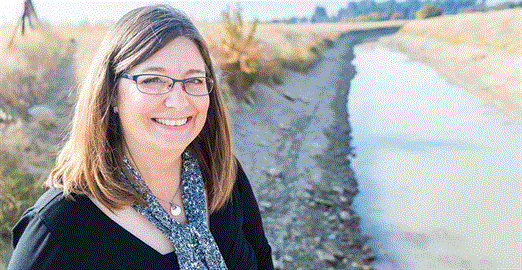
Clinicians searching for a new way to identify Valley fever patients who will develop the disease’s worst symptoms will find hope in a new paper by UC Merced Professor Katrina Hoyer .
A research project led by Hoyer and former UC Merced researcher Dan Davini, in collaboration with Madera’s Valley Children’s Healthcare, defines characteristics of blood cells that correlate with Valley fever symptoms. The Journal of Allergy and Clinical Immunology published the study .
“I am really excited about these results,” Hoyer said. “Right now, doctors who diagnose patients with Valley fever can’t tell whether they have to aggressively treat the disease and potentially cause additional harm to the patient or take a gentler approach that allows the patient’s body to clear the infection on its own.
“Our study points the way to a diagnostic tool that can answer that question.”
Valley fever is most common among adults who work outdoors. The disease comes from a fungal pathogen that becomes airborne when dirt is stirred up, such as during windstorms, when ground is broken for development or when workers harvest tree nuts.
The disease has reached record numbers in California but had been limited largely to the Southwest. However, the fungus has recently been found in eastern Washington, suggesting that changing climate is widening the region affected by Valley fever.
One of the most puzzling aspects of Valley fever is why some people get sick while others do not.
"Our team is working to improve future treatment for Valley fever patients within our community and beyond. This study is a first step toward reaching that goal."
About 60 percent of the people infected clear the fungus automatically, often without ever showing symptoms. About 35 percent of people will become ill or show symptoms but only need mild treatment. Between 1 percent and 4 percent of patients, however, develop a severe, chronic infection that can sometimes prove fatal.
Hoyer and her research team studied blood samples taken from children as they were diagnosed with Valley fever.
They discovered an increase in the number of cells that control the body’s response to infections — regulatory T cells — in the children likely to become ill, suggesting that too many regulatory T cells impair the body’s normal ability to destroy the fungus.
“Our goal is to understand the body’s basic responses to the pathogen, so we can manipulate those responses,” Hoyer explained. The next steps will be to see if the results translate to adult patients and conduct larger predictive studies.
More studies will lead to better diagnostics and help doctors make sure they are properly treating each patient according to the level of illness that can be expected, saving time, money and reducing treatment side effects.
Because many people with Valley fever present symptoms that mimic other infections, they often go through several rounds of antibiotics before being correctly diagnosed, contributing to the growing problem of antibiotic resistance.
As part of the Merced 2020 Project, the campus will soon have its own biosafety level 3 lab where infectious diseases such as Valley fever can be safely researched.
Hoyer, with the Department of Molecular and Cell Biology within the School of Natural Sciences, is affiliated with the Health Sciences Research Institute. She said she is already applying for grants to take this research to its next steps and is eager to work on Valley fever in the campus's new biosafety lab when it opens as part of the Merced 2020 Project expansion.
“Using our new findings, we want to develop a predictive test for clinicians to help them manipulate the immune responses during this infection,” she said. “Our team is working to improve future treatment for Valley fever patients within our community and beyond. This study is a first step toward reaching that goal.”

Senior Writer and Public Information Representative
Office: (209) 228-4406
Mobile: (209) 201-6255